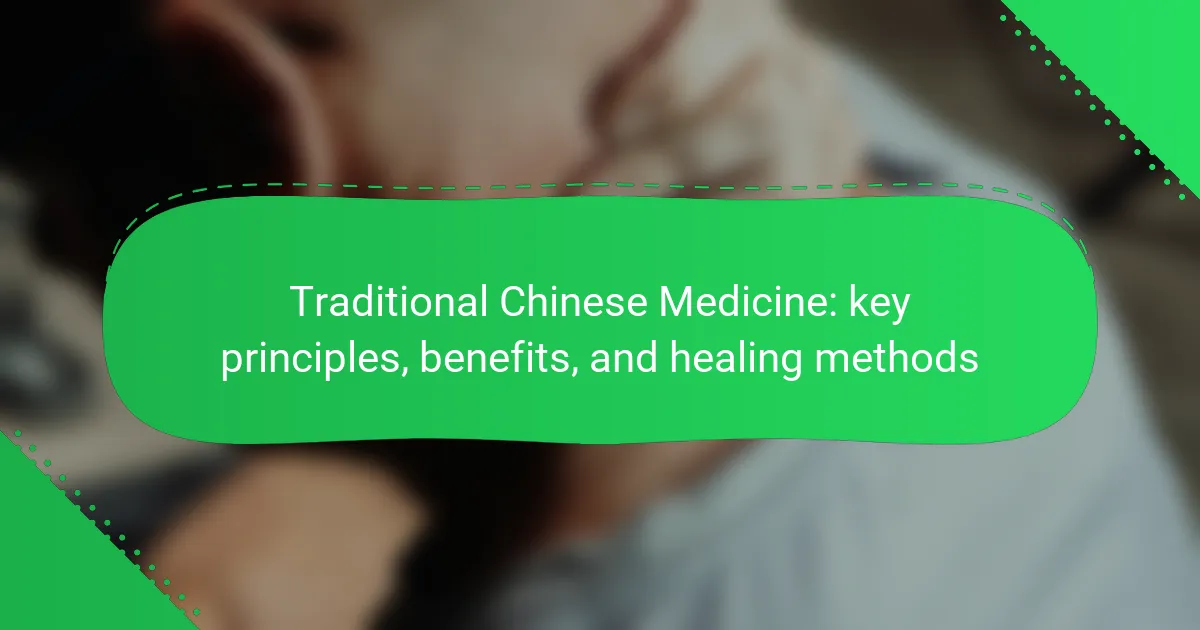Traditional Chinese Medicine offers a holistic approach to health, emphasizing balance and the interconnection of body and mind. Key principles include Yin and Yang, Qi, and the Five Elements theory. The article explores the benefits of TCM, such as improved energy and emotional well-being, and highlights various healing methods like acupuncture, herbal medicine, and Tai Chi. Additionally, it examines the cultural perceptions and regional variations in the acceptance of TCM practices worldwide.
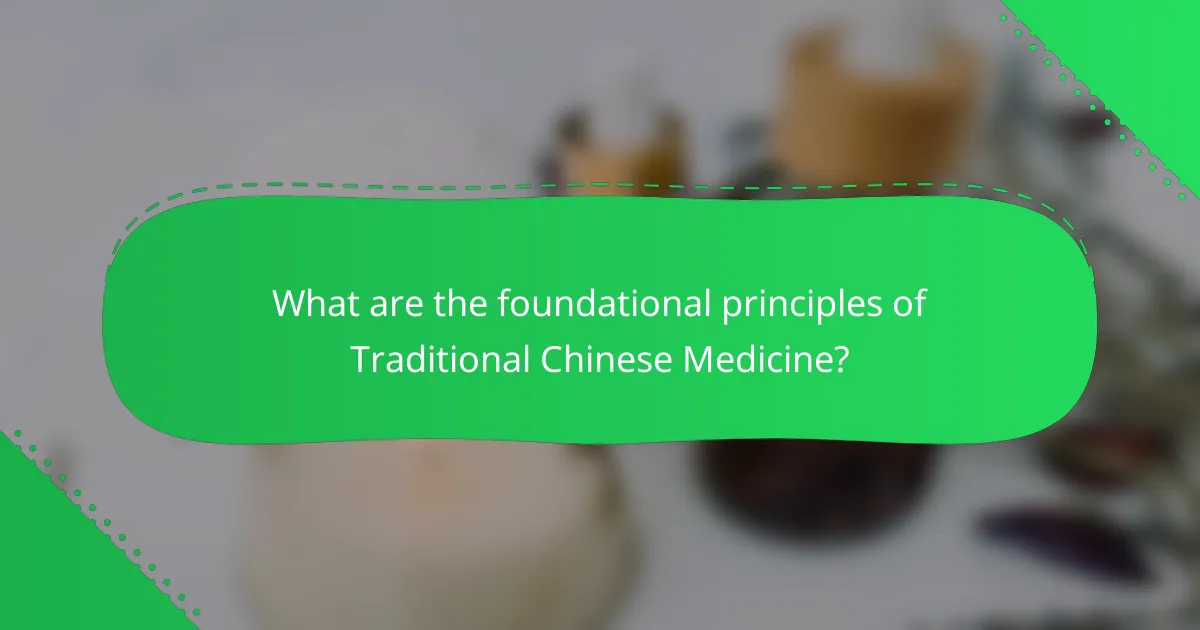
What are the foundational principles of Traditional Chinese Medicine?
Traditional Chinese Medicine is based on key principles such as balance, harmony, and the interconnection of body and mind. Core concepts include Yin and Yang, Qi (vital energy), and the Five Elements theory. These principles guide diagnosis and treatment, emphasizing prevention and holistic healing. Traditional Chinese Medicine offers benefits like improved health, enhanced well-being, and a natural approach to healing through methods like acupuncture, herbal medicine, and dietary therapy.
How does the concept of Qi influence health and wellness?
Qi profoundly influences health and wellness by promoting balance and harmony within the body. In Traditional Chinese Medicine, Qi represents vital energy that flows through pathways called meridians. Maintaining a balanced flow of Qi is essential for optimal health, as blockages or imbalances can lead to illness. Techniques such as acupuncture, herbal medicine, and Tai Chi aim to enhance Qi flow, thereby improving physical and mental well-being. Research shows that practices enhancing Qi can reduce stress, improve immune function, and promote overall vitality.
What role do Yin and Yang play in diagnosis and treatment?
Yin and Yang are fundamental in diagnosing and treating ailments in Traditional Chinese Medicine (TCM). They represent the balance of opposing forces, guiding practitioners to identify imbalances in a patient’s health.
In diagnosis, TCM practitioners assess the Yin and Yang relationship within the body. For example, excess Yang may indicate heat-related conditions, while excess Yin suggests cold or deficiency issues. This understanding shapes treatment strategies, aiming to restore equilibrium.
Treatment methods often involve acupuncture, herbal remedies, and dietary adjustments tailored to reestablish Yin and Yang balance. For instance, warming foods may be prescribed for Yang deficiency, while cooling herbs can address excessive Yang.
Overall, the interplay of Yin and Yang is crucial for holistic healing, ensuring that treatments address the root causes of health issues rather than just symptoms.
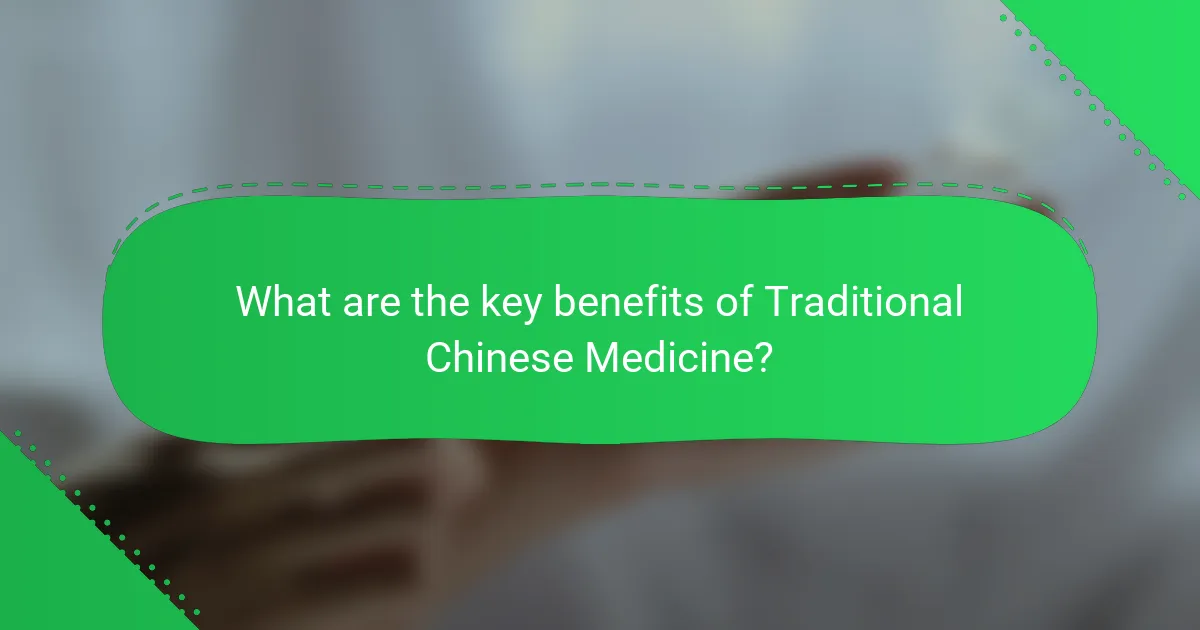
What are the key benefits of Traditional Chinese Medicine?
Traditional Chinese Medicine offers numerous benefits, including holistic healing, disease prevention, and balance restoration. It emphasizes treating the root cause of ailments rather than just symptoms. Key benefits include improved energy levels, enhanced mental clarity, and better emotional well-being. Additionally, it promotes natural healing methods such as acupuncture, herbal remedies, and dietary therapy. These practices can lead to improved immune function and overall health.
How can Traditional Chinese Medicine enhance mental health?
Traditional Chinese Medicine enhances mental health through holistic approaches, balancing body and mind. Techniques like acupuncture, herbal remedies, and Qi Gong promote emotional well-being and reduce stress. Research shows that acupuncture can alleviate symptoms of anxiety and depression, improving overall mental clarity. Herbal formulations, such as those containing ginseng, have been linked to increased energy and reduced fatigue, which can positively influence mood. Integrating these methods into daily routines fosters resilience against mental health challenges, supporting a balanced lifestyle.
What physical ailments can be treated effectively with Traditional Chinese Medicine?
Traditional Chinese Medicine effectively treats various physical ailments, including chronic pain, digestive disorders, respiratory issues, and stress-related conditions. It utilizes methods such as acupuncture, herbal therapy, and qi gong to promote healing. For instance, acupuncture can alleviate migraines, while herbal remedies may improve digestive health. These approaches emphasize balance and holistic well-being.
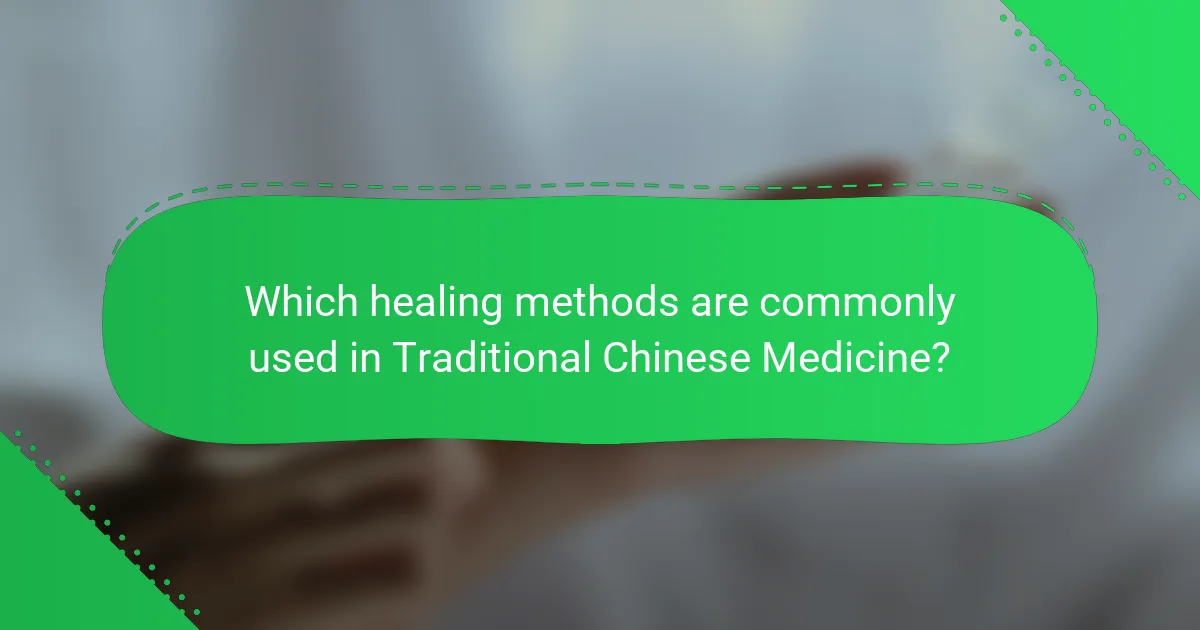
Which healing methods are commonly used in Traditional Chinese Medicine?
Traditional Chinese Medicine employs various healing methods including acupuncture, herbal medicine, cupping therapy, and Tai Chi. These methods aim to restore balance and promote overall health.
Acupuncture involves inserting fine needles into specific points to improve energy flow. Herbal medicine uses natural ingredients to address ailments and enhance well-being. Cupping therapy creates suction on the skin to stimulate blood flow and relieve pain. Tai Chi combines gentle movements and meditation to improve physical and mental health.
Each method reflects the core principle of achieving harmony within the body. This holistic approach differentiates Traditional Chinese Medicine from Western medical practices.
What is acupuncture and how does it work?
Acupuncture is a traditional Chinese medicine technique that involves inserting thin needles into specific points on the body to promote healing. It works by stimulating the body’s energy flow, or “Qi,” balancing physical and emotional health.
The key principles of acupuncture include the belief in the interconnectedness of body and mind, the importance of energy balance, and the use of meridians to guide treatment. The benefits of acupuncture range from pain relief and improved circulation to enhanced mental clarity and emotional well-being.
Acupuncture can be administered in various forms, including dry needling and electro-acupuncture. Each method targets unique attributes of the patient’s condition, ensuring personalized treatment. Additionally, acupuncture is often used alongside other traditional Chinese medicine practices, such as herbal therapy and dietary adjustments, to enhance overall healing.
How does herbal medicine differ from Western approaches?
Herbal medicine focuses on holistic healing and natural remedies, while Western approaches emphasize pharmaceuticals and surgical interventions. Traditional Chinese Medicine (TCM) integrates concepts like Qi, balance, and the body’s interconnectedness. TCM offers benefits such as improved digestion, pain relief, and stress reduction through methods like acupuncture and herbal formulations. In contrast, Western medicine often prioritizes symptom management over underlying causes.
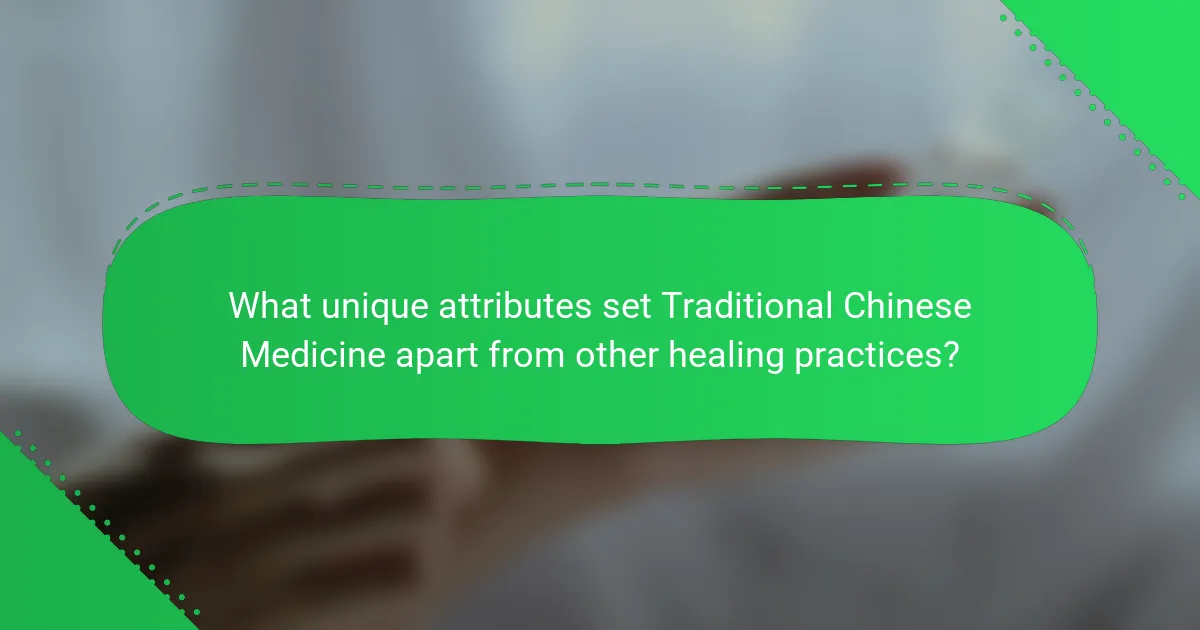
What unique attributes set Traditional Chinese Medicine apart from other healing practices?
Traditional Chinese Medicine stands out due to its holistic approach, emphasis on balance, and integration of mind-body concepts. It focuses on energy flow, known as Qi, and uses unique diagnostic methods like pulse and tongue analysis. Additionally, it incorporates a variety of healing methods, such as acupuncture, herbal medicine, and dietary therapy, which are tailored to individual needs. This personalized care is a rare attribute that differentiates it from many Western practices.
How does the holistic approach of Traditional Chinese Medicine address the mind-body connection?
Traditional Chinese Medicine (TCM) effectively addresses the mind-body connection through holistic practices. TCM emphasizes balance and harmony between physical and mental health, recognizing that emotional states can influence physical conditions. Techniques such as acupuncture, herbal medicine, and Qi Gong promote this connection by enhancing energy flow and reducing stress.
Root attributes include the integration of body, mind, and spirit. Unique attributes involve personalized treatment plans tailored to individual emotional and physical needs. Rare attributes may include specific practices like Tai Chi, which combines movement, meditation, and breath control. This comprehensive approach fosters overall well-being and resilience against stress-related ailments.
What specific techniques are exclusive to Traditional Chinese Medicine?
Traditional Chinese Medicine employs unique techniques such as acupuncture, herbal medicine, cupping therapy, and tai chi. Acupuncture involves inserting needles at specific points to balance energy. Herbal medicine utilizes natural plants for healing properties. Cupping therapy creates suction on the skin to improve blood flow. Tai chi combines gentle movements with deep breathing for overall wellness. Each technique reflects the holistic approach of Traditional Chinese Medicine.
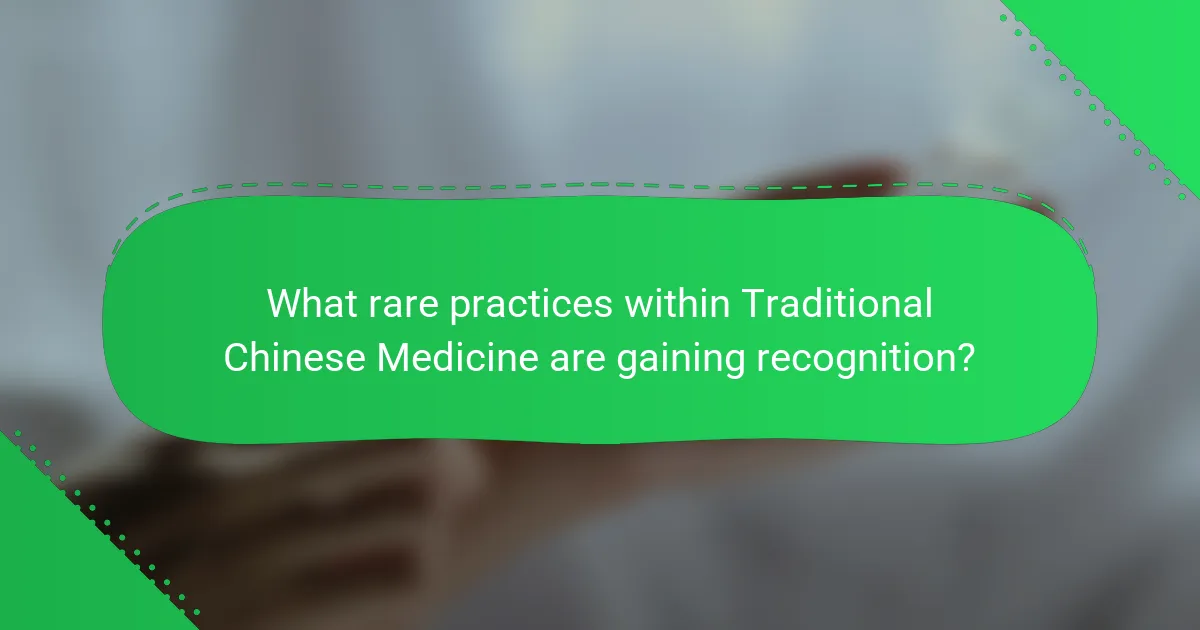
What rare practices within Traditional Chinese Medicine are gaining recognition?
Rare practices within Traditional Chinese Medicine gaining recognition include techniques like Gua Sha, which promotes circulation and reduces pain, and Cupping Therapy, known for alleviating muscle tension. Additionally, practices such as Moxibustion, which involves burning mugwort near acupuncture points, are increasingly acknowledged for their therapeutic benefits. These methods highlight the unique attributes of TCM, emphasizing holistic healing approaches that integrate body, mind, and spirit. As awareness grows, these practices are being embraced in Western wellness circles, reflecting a shift towards natural and preventive health care.
How is Qigong utilized for healing in specific communities?
Qigong is utilized for healing in specific communities through practices that promote physical, mental, and spiritual well-being. These techniques enhance energy flow, reduce stress, and improve overall health. In many cultures, Qigong serves as a complementary therapy alongside traditional medicine.
For instance, in Chinese communities, Qigong is often integrated into daily routines to manage chronic conditions such as hypertension and arthritis. Studies show that regular practice can lead to measurable improvements in flexibility and pain reduction.
Additionally, specific Qigong forms are tailored to address community health issues. For example, elder populations may focus on gentle movements that enhance balance and coordination.
As a result, Qigong not only fosters individual healing but also strengthens community ties through shared practice and holistic health approaches.
What are the less common modalities of treatment in Traditional Chinese Medicine?
Less common modalities of treatment in Traditional Chinese Medicine include techniques such as cupping, moxibustion, and Gua Sha. These methods focus on promoting energy flow and blood circulation. Cupping involves creating suction on the skin to alleviate pain and inflammation. Moxibustion uses the burning of mugwort near acupuncture points to enhance healing. Gua Sha involves scraping the skin to release muscle tension and improve circulation. Each modality offers unique benefits and is less frequently utilized compared to acupuncture and herbal medicine.
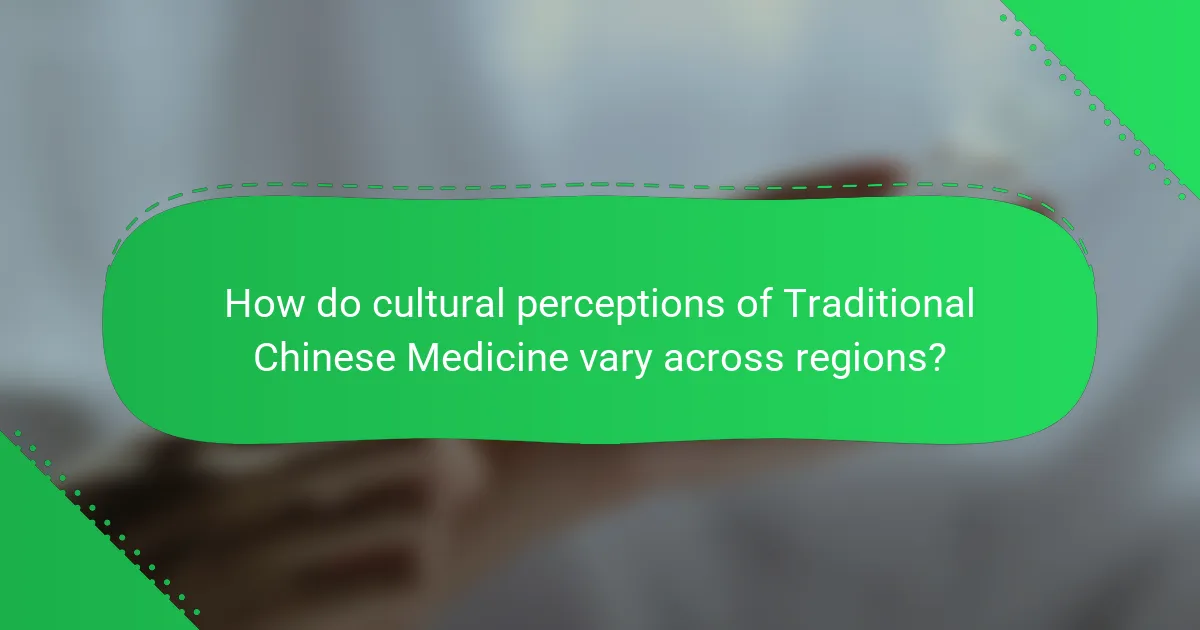
How do cultural perceptions of Traditional Chinese Medicine vary across regions?
Cultural perceptions of Traditional Chinese Medicine vary significantly across regions due to historical, social, and economic factors. In East Asia, TCM is widely accepted and integrated into healthcare systems, often seen as complementary to Western medicine. In contrast, Western countries may view TCM with skepticism, focusing on scientific validation and evidence-based practices.
Regional differences also influence the understanding of TCM principles, such as yin-yang and qi. For instance, in urban areas of China, TCM may blend with modern practices, while rural regions maintain traditional methods. Additionally, cultural beliefs about health and wellness shape the acceptance and application of TCM.
As a result, the effectiveness and relevance of TCM are perceived differently, impacting its adoption and integration into healthcare systems globally.
What are the common misconceptions about Traditional Chinese Medicine in Western cultures?
Many misconceptions about Traditional Chinese Medicine (TCM) in Western cultures include beliefs that it lacks scientific basis, is purely herbal, and is only effective for minor ailments. These misunderstandings stem from differences in medical paradigms. TCM emphasizes holistic health, balancing energy flow, and prevention, contrasting with Western medicine’s focus on symptoms. Some also mistakenly view acupuncture as solely a pain relief method, ignoring its broader applications in emotional and physical health. Additionally, the idea that TCM is outdated overlooks its integration with modern practices and ongoing research validating its efficacy.
How is Traditional Chinese Medicine integrated into modern healthcare systems?
Traditional Chinese Medicine (TCM) is increasingly integrated into modern healthcare systems through collaboration and complementary practices. This integration enhances patient care by combining TCM’s holistic approach with conventional medical treatments.
Healthcare providers recognize TCM’s benefits, such as pain management and stress reduction, and often refer patients for acupuncture or herbal therapies. Research supports TCM’s efficacy in treating chronic conditions, which encourages its acceptance in clinical settings.
Moreover, educational programs are emerging that train practitioners in both TCM and Western medicine, fostering a multidisciplinary approach. Hospitals increasingly offer TCM services alongside traditional treatments, reflecting a growing trend toward integrative healthcare.
This integration not only broadens treatment options but also promotes patient-centered care, addressing physical, emotional, and psychological health.
What practical tips can enhance the effectiveness of Traditional Chinese Medicine treatments?
To enhance the effectiveness of Traditional Chinese Medicine treatments, consider these practical tips.
1. Maintain a balanced diet that aligns with TCM principles, focusing on whole foods and seasonal ingredients.
2. Incorporate regular physical activity, such as tai chi or qigong, to promote energy flow and overall well-being.
3. Prioritize stress management techniques like meditation or acupuncture to support mental health.
4. Consult with a qualified TCM practitioner for personalized treatment plans tailored to individual needs.
5. Stay consistent with treatments and lifestyle changes to achieve long-term benefits.
